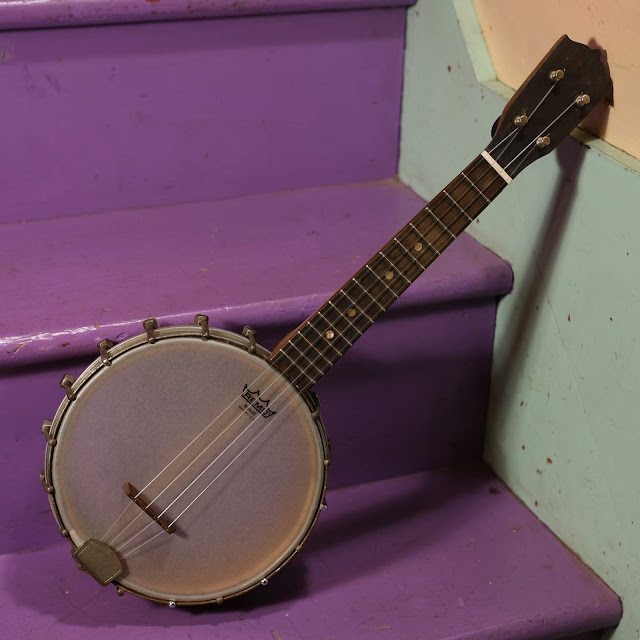1920s Stromberg-Voisinet (Kay) 8" Banjo Ukulele
This is another model of banjo-uke that I've worked-on quite a bit. Stromberg-Voisinet (in 1930, the company became Kay) ones of this type feature a longer 14" scale length and 8" rim which give them a bit more power and snap compared to the more-usual 13" scale and 7" rim of the time. As luck would have it, Remo now makes 8" banjo uke heads as a standard item these days, so one can go with a synthetic head which makes maintenance a lot less of a chore (no need to constantly tighten your old skin head in summer).
This is a customer's instrument and it arrived in a fairly-dilapidated state, needing many replacement parts and a lot of cleaning. It was filthy! After work, though, it's loud and direct and makes a great "jam-buddy."
Work included: a fret level/dress, tons of cleaning, many replacement (vintage) hooks+nuts+shoes, a new Remo Renaissance head, replacement (old) bridge, replacement (period, L&H patent) friction pegs, new bone nut, and setup.
Setup notes: it plays perfectly with 1/16" action at the 12th fret, has a straight neck, and is strung with D'Addario fluorocarbon.
Scale length: 14"
Nut width: 1 3/16"
String spacing at nut: 1"
String spacing at bridge: 1 5/16"
Head diameter: 8"
Rim depth: 2 1/2"
Rim material: ply maple w/maple veneer
Neck wood: maple
Fretboard: ebonized maple
Bridge: unknown hardwood, 1920s-era
Neck feel: medium v-shape, flat board
Condition notes: many replacement hooks, nuts, and shoes at the rim. Replacement head, replacement bone nut, replacement (period) tuners, replacement (old) bridge. The finish shows lots of wear and tear but still looks handsome despite it.
The interesting old bridge seems to be something like mahogany but it's so dirty/aged I can't tell. I needed a fairly tall one after resetting the neck angle, so this was the only one that suited from my bin of old banjo bridges.
The bakelite-buttoned friction pegs are a little nicer than normal as I replaced the half-gone original set with Lyon & Healy patent 1920s pegs which work better than your average friction pegs.















Comments